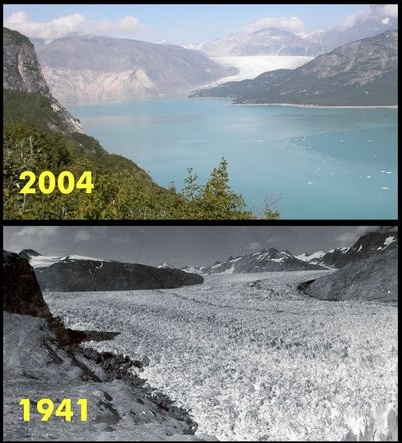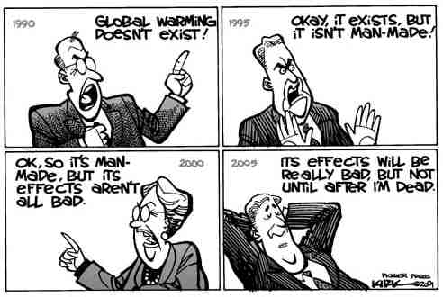An Earth history of sudden global climate changes.
What the scientists found was surprising and unnerving. They had known from previous ice core and ocean sediment core data that Earth’s climate had fluctuated significantly in the past. But what astonished them was the rapidity with which these changes occurred.
Ocean and lake sediment data from places such as California, Venezuela, and Antarctica have confirmed that these sudden climate changes affected not just Greenland, but the entire world. During the past 110,000 years, there have been at least 20 such abrupt climate changes. Only one period of stable climate has existed during the past 110,000 years–the 11,000 years of modern climate (the “Holocene” era). “Normal” climate for Earth is the climate of sudden extreme jumps — like a light switch flicking on and off.
http://www.wunderground.com/climate/abruptclimate.asp
IPPC: Climate Change 2013
“Warming of the climate system is unequivocal, … many of the observed changes are unprecedented over decades to millennia. The atmosphere and ocean have warmed, the amounts of snow and ice have diminished, sea level has risen, and the concentrations of greenhouse gases have increased
“Each of the last three decades has been successively warmer at the Earth’s surface than any preceding decade”
February 08, 2012
“Forty-six gigatons of ice from Alaskan glaciers was lost on average each year from 2003 to 2010. That’s according to data from NASA’s GRACE satellite, as analyzed by a team of scientists from the University of Colorado at Boulder.”
Sep 30, 2012
The IPCC wants world leaders to err on the side of caution in preparing their citizens for extreme weather events that will likely become more frequent; earlier this year they released a report entitled “Managing the Risks of Extreme Events and Disasters to Advance Climate Change Adaptation” to help policymakers do just that. The report is considered a must read in coastal, arid and other especially vulnerable areas.
As for the U.S. government, the National Oceanic and Atmospheric Administration (NOAA) tracks weather and storms, while the Federal Emergency Management Agency (FEMA) deals with the impacts of extreme weather and other disasters. But critics would like to see Congress and the White House do more to increase Americans’ preparedness. “The U.S. [in 2011] experienced a record fourteen weather-related disasters each in excess of a billion dollars-and many more disasters of lesser magnitudes,” reports the non-profit Climate Science Watch (CSW). “Yet the U.S. has no national climate change preparedness strategy; and Federal efforts to address the rising risks have been undermined through budget cuts and other means.” CSW and others are calling for the creation of a new cabinet-level agency called the National Climate Service to oversee both climate change mitigation as well as preparedness for increasingly extreme weather events.
from www.scientificamerican.com/article.cfm?id=climate-change-and-extreme-weather
This global warming, it’s devastating to the ecology. It’s happening so much faster than the scientists are saying. … they think the danger is decades away. It’s not; it’s here!
– The Three Waves of Volunteers and the New Earth by Dolores Cannon
ABC News On Stunning Greenland Ice Melt:
‘Scientists Say They’ve Never Seen Anything Like This Before’
By Joe Romm on Jul 24, 2012 at 7:56 pm
July 24, 2012: For several days this month, Greenland’s surface ice cover melted over a larger area than at any time in more than 30 years of satellite observations. Nearly the entire ice cover of Greenland, from its thin, low-lying coastal edges to its two-mile-thick center, experienced some degree of melting at its surface, according to measurements from three independent satellites analyzed by NASA and university scientists.
On average in the summer, about half of the surface of Greenland’s ice sheet naturally melts. At high elevations, most of that melt water quickly refreezes in place. Near the coast, some of the melt water is retained by the ice sheet and the rest is lost to the ocean. But this year the extent of ice melting at or near the surface jumped dramatically. According to satellite data, an estimated 97 percent of the ice sheet surface thawed during mid-July.
The melting spread quickly. Melt maps derived from the three satellites showed that on July 8, about 40 percent of the ice sheet’s surface had melted. By July 12, [4 days later!] 97 percent had melted.
Last year, scientists explained that the Greenland Ice Sheet “could undergo a self-amplifying cycle of melting and warming” that is “difficult to halt.”
– http://thinkprogress.org/climate/2012/07/01/508782/greenland-ice-sheet-melt-nearing-critical-tipping-point/
http://thinkprogress.org/climate/2012/07/24/580371/abc-news-on-stunning-greenland-ice-melt-scientists-say-theyve-never-seen-anything-like-this-before/?mobile=nc
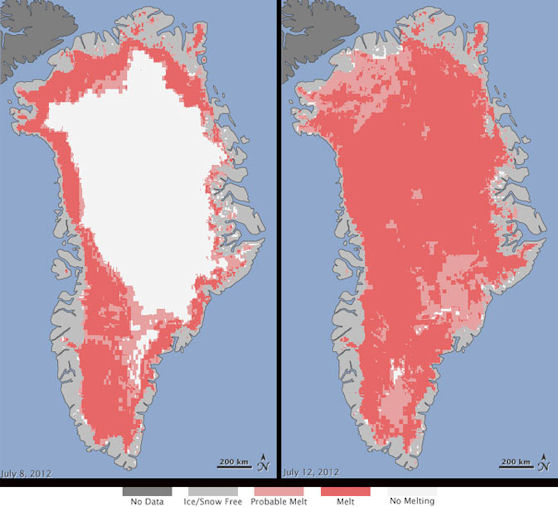
Anchorage Daily News
Record melt of Arctic sea ice: “It’s hard even for people like me to believe, to see that climate change is actually doing what our worst fears dictated,” said Jennifer A. Francis, a Rutgers University scientist who studies the effect of sea ice on weather patterns. Scientific forecasts based on computer modeling have long suggested that a time will come when the Arctic will be completely free of ice in the summer, perhaps by the middle of the century. This year’s prodigious melting is lending credibility to more pessimistic analyses that it may come much sooner, perhaps by the end of the decade. “It’s an example of how uncertainty is not our friend when it comes to climate-change risk,” said Michael E. Mann, a climate scientist at Pennsylvania State University. “In this case, the models were almost certainly too conservative in the changes they were projecting, probably because of important missing physics.”
“climate change … an outcome of distortions in the atmosphere that lead over time to a breaking point, and sudden catastrophe. This planet is at present a death trap.
“… as polar ice melts and floods the northern ocean with freshwater, the North Atlantic Current would fail, leading to a radical climate change that would unfold over “a single season”.
In 2008 Dr. Achim Brauer, of the Potsdam Center for Geosciences, and colleagues analyzed sediments from a crater lake that are laid down annally, and found that the “Younger Dryas” thirteen thousand years ago began over a single season, which is ten times faster than previously believed.– The Key pg.20, by Whitley Strieber
“Younger Dryas climate event”: “These findings hint that shifts in the flow of water in the Arctic could dramatically alter today’s climate.”
see www.ouramazingplanet.com/3735-big-freeze-flood.html
The Atlantic Monthly : The Great Climate Flip-flop, by WILLIAM H. CALVIN
www.williamcalvin.com/1990s/1998AtlanticClimate.htm
“I’ve puzzled over why the news media never had anything to say about the topic, even when well written news stories in Science and Nature should have helped to pave the way for science reporters to write about flip-flop climate tendencies. This isn’t just another annoying detail of the greenhouse warming, but an abrupt cooling, one that has happened many times before, and potentially a catastrophic consequence of gradual warming” – William H. Calvin
“Weather patterns can permanently shift in as little as a year, according to the records preserved in an ice core from Greenland”
www.scientificamerican.com/article.cfm?id=ice-core-reveals-how-quickly-climate-can-change
Jul 28, 2012 Bombshell:
Koch-Funded Study Finds ‘Global Warming Is Real’, ‘On The High End’ And ‘Humans Are Almost Entirely The Cause.’
… “essentially all of this increase results from the human emission of greenhouse gases. … In short, a Koch-funded study has found that the IPCC “consensus” underestimated both the rate of surface warming and how much could be attributed to human emissions!”Koch has been the worst global warming liar on the planet!:
Koch Industries outspends Exxon Mobil on climate and clean energy disinformation
Arctic ice melts to record low levels
The sea ice in the Arctic Ocean has melted to its smallest point ever in a milestone that may show that worst-case forecasts on climate change are coming true, US scientists said Monday.
The extent of ice observed on Sunday broke a record set in 2007 and will likely melt further with several weeks of summer still to come, according to data from the National Snow and Ice Data Center and the Nasa space agency.
The government-backed ice centre, based at the University of Colorado at Boulder, said in a statement that the decline in summer Arctic sea ice “is considered a strong signal of long-term climate warming.”
The sea ice fell to 4.10 million square kilometres (1.58 million square miles), some 70,000 square kilometres (27,000 square miles) less than the earlier record charted on September 18, 2007, the centre said.
Scientists said the record was all the more striking as 2007 had near perfect climate patterns for melting ice, but that the weather this year was unremarkable other than a storm in early August.
Michael E. Mann, a lead author of a major UN report in 2001 on climate change, said the latest data reflected that scientists who were criticised as alarmists may have shown “perhaps too great a degree of reticence.”
“I think, unfortunately, this is an example that points more to the worst-case scenario side of things,” said Mann, director of the Earth System Science Center at Penn State University.
“There are a number of areas where in fact climate change seems to be proceeding faster and with a greater magnitude than what the models predicted,” Mann told AFP.
“The sea ice decline is perhaps the most profound of those cautionary tales because the models have basically predicted that we shouldn’t see what we’re seeing now for several decades,” he added.
Arctic ice is considered vital for the planet as it reflects heat from the sun back into space, helping keep down the planet’s temperatures.
The Arctic region is now losing about 155,000 square kilometres (60,000 square miles) of ice annually, the equivalent of a US state every two years, said Walt Meier, a scientist at the National Snow and Ice Data Center.
“It used to be the Arctic ice cover was a kind of big block of ice. It would melt a little bit from the edges but it was pretty solid,” Meier told reporters on a conference call.
“Now it’s like crushed ice,” he said. “At least parts of the Arctic have become like a giant slushie, and that’s a lot easier to melt and melt more quickly.”
The planet has charted a slew of record temperatures in recent years, with 13 of the warmest years ever taking place in the past decade and a half, along with extreme weather ranging from severe wildfires in North America to major flooding in Asia.
Researchers have also reported a dramatic melt this summer on the ice sheet in Greenland, which could have major consequences for the planet by raising sea levels.
But efforts to regulate emissions have faced strong political resistance in several nations including the United States, where industry groups have said that regulations would be too costly for the economy. [co’s controlling government]
Kumi Naidoo, the executive director of Greenpeace who on Monday intercepted a Russian ship in the Arctic, said the ice melt showed that the planet was “warming up at a rate that puts billions of people’s future in jeopardy.”
“These figures are not the result of some freak of nature but the effects of man-made global warming caused by our reliance on dirty fossil fuels,” he said in a statement.
Shake Wolf of the Center for Biological Diversity pressure group called the record ice melt “a profound – and profoundly depressing – moment in the history of our planet.”
The melt has rapidly changed the politics and economics of the Arctic region, with shipping companies increasingly eager to save time by sailing through the once-forbidding waters.
Data released Monday by the Washington-based Center for Global Development found that nations including China, India and the United States were reducing the intensity of their carbon emissions but that the effort was overwhelmed by the surge in power consumption in developing nations.
http://www.telegraph.co.uk/science/science-news/9502543/Arctic-ice-melts-to-record-low-levels.html
Sept. 25, 2012
How The Arctic Death Spiral Fuels A “Wicked Backlash On Our Weather”

“the volume dropped by 75% during that time, [summer 1980 – summer 2012] making a reversal of this trend anytime soon exceedingly improbable.”
from http://thinkprogress.org/climate/2012/09/25/904311/how-the-arctic-death-spiral-fuels-a-wicked-backlash-on-our-weather/
Sperry glacier, Montana and Upsala glacier, Argentina
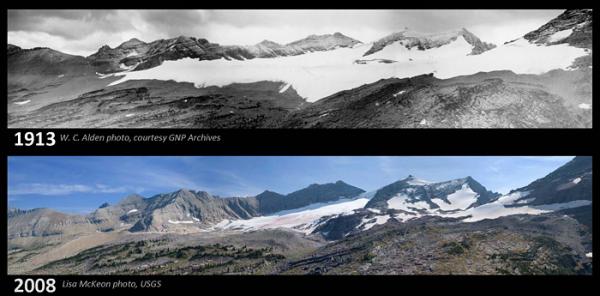
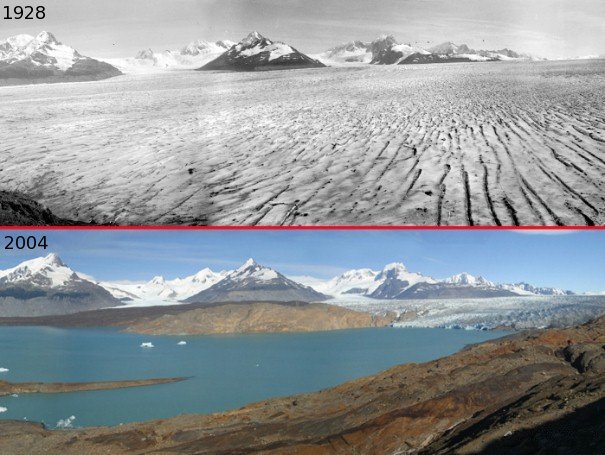
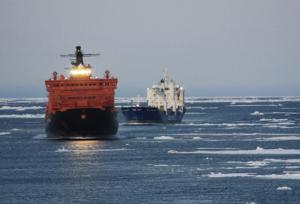
“Arctic riches unlocked by global warming will not begin to make up for the costs of climate change”
see
http://www.economist.com/node/21556805
The World Bank estimates the cost of adapting to climate change between 2010 and 2050 at $75 billion-100 billion a year; other estimates are higher.
also see
http://environment.nationalgeographic.com/environment/global-warming/
“The whole panet is heating up and the Arctic is warming twice as fast as the rest:
“Since 1951 it has warmed roughly twice as much as the global average
“greenhouse-gas emissions are soaring
“mainly from carbon dioxide released when fosil fuels are burned.
[coal fired power plants and oil,gasoline,diesel, transportation]– The Economist, June 16th – 22nd 2012
In July 2012, even local TV weather reporters were reflecting everyone’s comments on how much hotter the summer was all over the country and finally saying “climate change” if not “global warming” which it is finally too much to deny.
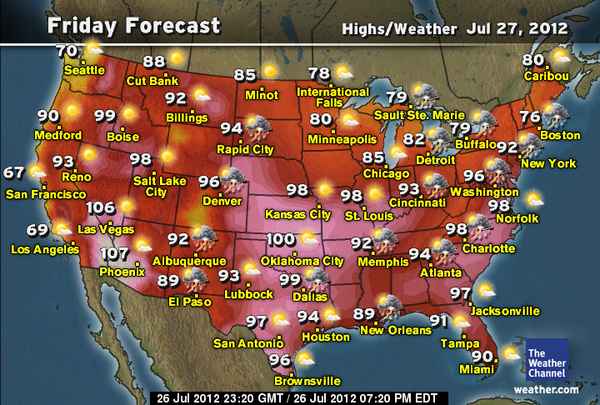
July Hottest Month on Record, Top NASA Scientist Says It’s Climate Change
By ICTMN Staff August 9, 2012
No other explanation is possible for events ranging from last year’s Texas drought and the 2010 heat wave in Russia, said James Hansen, who directs the Goddard Institute for Space Studies at the U.S. National Aeronautics and Space Administration (NASA), in an interview with Bloomberg.
“You would not have these extremes without global warming,”
Climatic Stress Increases Forest Fire Severity across the Western United States: A growing concern over current warming trends in the western United States is increased wildfire probabilities, leading to tree deaths (and subsequent losses of carbon, watershed integrity and wildlife habitat). The situation may be made worse if trees respond to increasing temperatures and droughts by becoming increasingly sensitive to fire.

